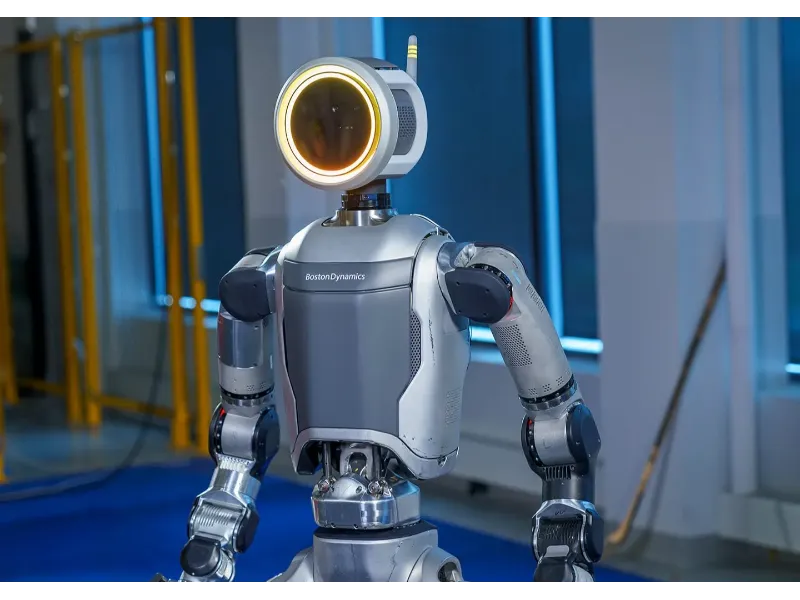- Atlas, a bipedal humanoid robot developed by Boston Dynamics, was initially designed for search and rescue tasks and unveiled in 2013.
- The robot has gone through significant updates and enhancements, including the development of its hands by Sandia National Laboratories and iRobot.
- Boston Dynamics introduced a new fully electric version of Atlas in April 2024, featuring improved motion capabilities and a redesigned appearance.
Recently, Boston Dynamics announced the launch of a new electrically-driven robot and officially retired its hydraulic-driven robot, Atlas. This significant move symbolises the leading hydraulic-driven technology company’s transition to electric-driven technology, bringing positive implications for the current mainstream development direction of electric-driven joint technology.
The first appearance of the Atlas robot
Atlas is a bipedal humanoid robot primarily developed by the American robotics company Boston Dynamics, with funding and oversight from the U.S. Defense Advanced Research Projects Agency (DARPA). The robot was initially designed for a range of search and rescue tasks and was publicly unveiled on July 11, 2013.
Sandia National Laboratories developed one of Atlas’ hands, while the other was developed by iRobot. In 2013, Gill Pratt, the program manager at DARPA, likened the prototype version of Atlas to a small child, explaining that “a 1-year-old child can barely walk, a 1-year-old child falls down a lot … this is where we are right now.”
Also read: Should robots go to space instead of humans?
Atlas is the successor to Boston Dynamics’ earlier PETMAN humanoid robot and features blue LED lighting. It comes equipped with two vision systems – a laser rangefinder and stereo cameras – both controlled by an off-board computer. Atlas also possesses hands with fine motor skill capabilities, and its limbs offer a total of 28 degrees of freedom. While the 2013 prototype version relied on an external power supply, Atlas can now navigate challenging terrain and climb independently using its arms and legs.
Also read: Paid ChatGPT can remember user preferences
Boston Dynamics introduces electric version of Atlas
On April 16, 2024, Boston Dynamics made an announcement on their YouTube channel regarding the retirement of Atlas. Following this announcement, on April 17, 2024, the company released another YouTube video introducing a brand new version of Atlas. This new iteration is fully electric and showcases significant improvements, including a comprehensive remodel and an expanded range of motion.

Although the 39-second short video released by Boston Dynamics has limited duration, it vividly showcases the technological breakthroughs embodied by their “new electric Atlas” robot. In the video, the electric Atlas starts from a lying position, and with the quiet yet determined operation of its motors, its legs demonstrate extraordinary flexibility as it bends at the knees and twists its body into unconventional human-like postures, successfully standing up without the need for hand support. This seemingly lazy lying position is actually a demonstration of the robot’s quick positional changes through clever leg rotation strategies.
Another highlight of the electric Atlas is its unique “agile turning” capability. Initially facing away from the camera, Atlas swiftly rotates its head 180 degrees, causing the upper body to follow suit. Subsequently, the upper body and head cooperate once again to rotate 180 degrees, smoothly manoeuvring the robot in front of the camera and out of the frame. Although its gait still appears somewhat rigid, compared to many commercially available humanoid robots, the electric Atlas exhibits noticeably more natural and fluid movements.
Boston Dynamics officially stated that the new electric Atlas, compared to its previous hydraulic version, has shown significant improvements in terms of both strength and range of motion. The new design eliminates the high centre of gravity, bulky structure, and clearly visible joints. The robot’s body no longer features exposed cables, and the integration of the mechanical skeleton is higher to the extent that it is difficult to discern its front and back from its appearance alone. This further emphasises that Boston Dynamics’ design philosophy for humanoid robots is not solely focused on achieving a highly realistic human form, but rather aims to create a new type of humanoid robot based on optimised functionality and technological innovation.
Robot technology undergoes a transition
The hydraulic-powered version of the Atlas robot was initially developed to tackle the challenges of rescue tasks in complex environments. Over time, Boston Dynamics has continuously updated and upgraded its design and functionality, enabling it to run, jump, and perform various gymnastic movements. However, the inherent limitations of the hydraulic system have gradually become apparent. These include high costs, significant operational noise, limited adaptability due to pre-programmed actions, and maintenance difficulties arising from increased size and weight. These factors hinder the widespread application of the Atlas robot in various scenarios.
With the advancement of AI technology, especially in large-scale models, Boston Dynamics has strategically adjusted its technological path to move towards higher levels of automation and embodied intelligence. The hydraulic version of Atlas seems to reflect the end of an era in this technological transformation, while a more practical and cost-effective robotic technology system is emerging.
Although there is much discussion about the potential of versatile general-purpose humanoid robots in the industry, most robot systems still focus on handling basic task operations, such as moving objects from point A to point B. To truly achieve the versatile application of robots in various complex scenarios, it will require broader and deeper breakthroughs in intelligent technology.

